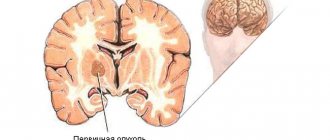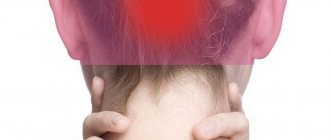Causes of headaches that radiate to the eyes
Headaches that extend to the eyes are often localized in the frontal lobe. It may primarily occur due to circulatory disorders in the brain, vascular spasms, inflammatory and other processes. In some cases, it indicates ophthalmological problems and therefore requires different treatment tactics. Determining the cause is a key stage of treatment, but it is impossible to carry out all procedures at home. The Clinical Brain Institute specializes in such problems, and doctors will provide a consultation and a complete informative examination.
Migraine
Migraine is an acute headache. It occurs in attacks and can be associated with various factors. Many patients complain of meteorological dependence, that is, the occurrence of attacks when weather conditions change. Migraines can also worsen after prolonged physical activity and nervous tension, with lack of sleep and poor diet. It can be determined for a number of characteristic reasons:
- attacks are often unilateral, occur abruptly, and have moderate or high intensity;
- headache radiates to the eyes, intensifies when bright light hits the retina;
- nausea, weakness, deterioration in health are additional signs.
Migraine is a chronic condition with a relapsing course. It may first appear after trauma or concussion, as well as with damage to the cervical spine. In some cases, it becomes less pronounced or goes away completely over time, but many patients suffer from its manifestations in old age.
Pressure changes
Hypertension is an increase in blood pressure. It is often accompanied by chronic aching pain that spreads over the entire surface of the head and radiates into the eyes. This symptom can be determined at home, using a regular tonometer. Hypertension can be a consequence of physical exertion or emotional stress, as well as high temperature and many other factors. You can lower your blood pressure with medications, as prescribed by your doctor. For this disease, diuretics, calcium channel blockers and beta-blockers, as well as sedatives and other drugs are used.
Separately, there is an increase in intracranial pressure. This occurs when fluid accumulates in the cerebral ventricles and its outflow is disrupted. Normally, the circulation of cerebrospinal fluid (CSF) occurs continuously. It enters from the spinal canal into the ventricles of the brain, but does not stay here for long and is quickly removed through the venous sinuses. Intracranial pressure is a precise value that consists of the resistance of several fluids:
- blood that is in the cerebral arteries;
- cerebrospinal fluid;
- actual brain tissue.
Another indicator that needs to be measured when pain radiates into the eyes occurs is intraocular pressure. It is created by aqueous humor, and its increase causes visual impairment and pressing pain, which can spread to the patient's head. Chronic increase in intraocular pressure is called glaucoma and can lead to dangerous consequences - there is a risk of optic nerve atrophy and the development of blindness.
Intraocular pressure can be easily measured with a tonometer - this procedure is included in a standard ophthalmological examination. Intracranial pressure is difficult to determine, and accurate data can only be obtained by puncturing the cerebrospinal fluid. This procedure is painful and is performed only in extreme cases.
Diseases of the visual apparatus
Chronic eye strain is one of the most common causes of headaches. It especially often manifests itself in employees who spend a long time in front of a monitor, as well as in representatives of professions where it is necessary to focus on small objects for a long time. For such patients, it is enough to provide the eyes with short-term but regular rest, as well as perform exercises to develop the eye muscles.
Other illnesses that can cause headaches include:
- myopia or farsightedness;
- inflammation of the optic nerve is a dangerous condition that requires urgent medical attention;
- dry eye syndrome - decreased secretion of the lacrimal glands, including with increased air pollution.
The pain can be initially localized in the eyes, and then spread to the entire surface of the head. So, its cause is often damage or inflammation of the conjunctiva - the mucous membrane of the eyes. An attack of pressing pain may be associated with the entry of a foreign body, after which small marks remain on the mucous membrane. When trying to maintain the most comfortable position, the eye muscles are constantly in a tense position.
Injuries and their consequences
A concussion, open or closed craniocerebral injury necessarily manifests itself as an acute pain syndrome. Even a slight concussion causes visual disturbances, pain in the eyes and the appearance of black spots in the field of vision. Treatment tactics may vary depending on the type and severity of the injury. Painful sensations can occur not only during the period of treatment and rehabilitation, but also many years later. They are associated with impaired blood circulation and innervation in the affected areas of the brain, ischemia of nerve tissue and insufficiency of nerve conduction. The fight against long-term consequences is carried out with drugs to improve blood supply to the brain, with the obligatory abandonment of bad habits and lifestyle correction.
Infectious diseases
Colds, which develop due to the activation of pathogenic microflora, occur with headaches. It gets into the eyes, and photophobia and lacrimation may occur. Discomfort increases in bright light. Flu and acute respiratory viral infections are common, so many patients prefer to endure these diseases on their feet. However, they also require timely treatment and can lead to dangerous complications. Infectious diseases are manifested by characteristic symptoms:
- increased temperature (usually no more than 37.5 degrees);
- pressing headache that radiates to the eyes;
- weakness, decreased performance;
- discharge from the eyes and nose;
- Symptoms are worsened by bright lights or loud noises.
Infectious diseases should be distinguished from allergic reactions. An allergy is a pathological reaction of the human immune system. It mistakes normal substances for foreign substances and triggers defense mechanisms. Such substances can be any allergens, and headaches are most often caused by those that enter with inhaled air: dust, pollen, wool and others. Immune reactions occur with inflammation, redness and swelling of the mucous membranes. They are often accompanied by a nagging headache that spreads to the eyes. It is difficult for the patient to stay in a lit room - this causes an exacerbation of allergy symptoms.
Inflammation of the paranasal sinuses
Acute pain in the forehead that spreads to the eyes may be one of the symptoms of sinusitis. The paranasal sinuses are natural cavities in the skull filled with air. If the inflammatory process begins here with the proliferation of infection, they are filled with contents (serous, purulent, with impurities of blood). The most common form of sinusitis is sinusitis. The disease is an inflammation of the maxillary (maxillary) sinus and requires urgent treatment. If the contents of the maxillary sinus are not removed, there is a risk of complications in the form of meningitis (inflammation of the lining of the brain). This disease can be recognized by its characteristic signs:
- pressing pain, which is localized mainly in the frontal lobe of the head;
- the appearance of discharge from the eyes and nose;
- increased temperature, general weakness;
- increased pain when sharply tilting the head down and forward;
- A dull sound when tapping the maxillary sinuses indicates an accumulation of fluid or pus.
Another manifestation of sinusitis is frontal sinusitis, inflammation of the frontal sinus. Its symptoms are similar to those of sinusitis and are also accompanied by chronic headache, and the diagnosis can only be made on the basis of percussion data. When you tap the frontal sinuses (they are located behind the brow ridges and connect to the nasal cavity), a dull sound appears. which directly indicates the accumulation of contents.
Other causes of headaches that radiate to the eyes
One of the reasons why a headache appears and spreads to the eyes is the incorrect selection of lenses or glasses. These accessories should only be selected after an ophthalmological examination. If you wear lenses with unsuitable characteristics, as well as low-quality materials, this will lead to constant tension in the eye muscles and headaches. This may be caused by using expired lenses or failure to comply with one of the characteristics:
- lens material - modern models are made from the most suitable compounds, but they can also cause allergies and irritation of the mucous membranes;
- moisture content - lenses with a high water content are recommended for beginners, although they are easier to damage;
- oxygen permeability - this characteristic is higher in lenses designed for long-term wear;
- the diameter of the lens and the radius of its curvature - these indicators ensure a comfortable fit on the eyes, so the selection of lenses can only be carried out by an ophthalmologist.
Prolonged stay in a dusty room, in bright light or at high temperatures. This leads to dry eye syndrome and impaired secretion of the lacrimal glands. The same symptoms are observed with intense exposure to ultraviolet rays on the conjunctiva of the eye. Its damage causes acute headache, lacrimation and decreased visual acuity. The mucous membrane recovers over time, and during the treatment process it is recommended to reduce any stress on the eyes.
When to see a doctor if you have eye pain
If your eyes hurt, you cannot do without medical advice. This is necessary to make a diagnosis and begin proper treatment.
Sometimes the cause of pain in the eye is immediately clear (for example, when pain occurs as a result of a foreign body entering the eye), but in most cases it is necessary for the diagnosis to be made by a specialist - an ophthalmologist.
It should be remembered that pain in the eye can mean the threat of a sharp deterioration or even loss of vision.
You should definitely consult a doctor if:
- foreign body getting into the eye;
- bruise in the eye area;
- dull pain in the eye lasting more than two days;
- sharp, piercing pain in the eye;
- pain in the eye accompanied by blurred vision;
- pain in the eye, accompanied by symptoms such as nausea, vomiting, increased sensitivity to light.
If a child’s eyes hurt, he should definitely be shown to a pediatric ophthalmologist.
Diagnostic and treatment methods
Treatment methods are selected individually. Only an experienced doctor will be able to determine the causes of headaches and prescribe the most effective treatment regimen. The Clinical Brain Institute specializes in the diagnosis and treatment of such disorders, and also offers individual rehabilitation programs. The examination includes several stages. The first of them will require a general examination by a therapist and an ophthalmologist; then, if necessary, additional procedures may be prescribed:
- encephalography - study of the state of the brain;
- radiography and ultrasound;
- MRI of the head is the most informative diagnostic method;
- blood tests - prescribed if infectious diseases are suspected.
In our clinic you can sign up for a consultation with specialized specialists who practice treating headaches in patients of any age. Treatment in most cases is medicinal and may include taking antibiotics, anti-inflammatory and painkillers, drugs to improve blood circulation in the brain, as well as eye ointments and drops.
Clinical Brain Institute Rating: 4/5 — 14 votes
Share article on social networks
What is atrial scotoma?
By ocular migraine, experts mean a type of headache with a complex of neurological manifestations, including visual abnormalities. The pathology was first described in the 19th century, but the mechanism of its occurrence was presented in more detail by modern physiologists. It is believed that the tendency to ocular migraine is inherited genetically through the female line. Men suffer from it in isolated cases.
Atrial scotoma has no direct relation to ophthalmology; however, during an attack, serious disturbances in visual perception may occur. According to statistics, pathology is a companion to the physiological and physical maturation of the body, that is, at a young age. Due to the instability of the autonomic nervous system, attacks can recur several times a month. In older age, migraine bothers people who have to experience visual stress for a long time.
Linear progression is not typical for atrial scotoma. The attacks arise and subside spontaneously. Complications do not occur even after prolonged exacerbations, although at the peak of pain, complete loss of vision is possible. After relief of the main neurological symptoms, the ability to see is restored independently.
Symptoms of ocular migraine
Based on its clinical manifestations, atrial scotoma is difficult to confuse with other ophthalmological diseases. In the retinal form, provoked by abnormal relaxation of the posterior cerebral artery, the patient is concerned about:
- defects appearing in the field of view - bright flashes, flickering, dark spots and streaks that can merge with each other;
- gradual total decrease in visual acuity;
- the appearance of phosphenes (visual images) in the “blind” zones of the visual field and along its periphery.
As ocular migraine worsens, it becomes complicated by headache localized in the frontal lobe, bridge of the nose, spreading to the orbits. It pulsates, waxes and wanes, like contractions during childbirth, inevitably reaching a peak. At the peak of the attack, pain is complicated by nausea, vomiting, and a feeling of fullness in the head.
Good to know: a characteristic symptom of ocular migraine is increased sensitivity to light, sounds, and touches. They increase the pain, so the patient strives with all his might for solitude and silence.
The average duration of an attack of atrial scotoma is from 30 to 300 minutes. A mild degree of anomaly occurs within 10-20 minutes, sometimes not accompanied by headaches. After the end of the attack, it takes up to 1 hour for complete restoration of vision.
If atrial scotoma is caused by compression of the 3rd pair of cranial nerves, the patient experiences:
- transient drooping of the upper eyelid;
- dilation of the pupil in one eye while maintaining the same size in the other;
- dilation of the pupil against the background of paralysis of the muscles that regulate its diameter;
- divergent strabismus due to paralysis of the extraocular muscles in one eye.
Among the visual impairments with ocular migraine of this form, a split image is observed, when one eye perceives the picture correctly, and the other transmits an image inverted horizontally or vertically. This picture is typical for children and adolescents who have entered puberty.
Good to know: ocular migraine with compression of the cranial nerves has a specific “Alice syndrome”, which consists of the appearance of visual hallucinations visible in peripheral vision.
Symptoms with ophthalmoplegic atrial scotoma last longer than with retinal scotoma - up to 2 weeks. All this time, the anomalies may be accompanied by headaches, but often occur without them.
How to quickly relieve tired eyes
During the break, perform light eye exercises:
- Look into the distance for 20 seconds, focus on an object that is located about 20 steps away from you;
- Close your eyes and make four rotations with your eyeballs - first clockwise, then counterclockwise;
- Without opening your eyelids, move your eyes up and down;
- Complete the exercise by blinking frequently for 30 seconds. The gaze is directed forward.
To consolidate the effect, drip your eyes with moisturizing drops selected by an ophthalmologist. Do not self-medicate, be sure to seek help from a specialist - moisturizing drops come in different viscosities, they can have a therapeutic effect, or they can simply wet the surface of the eye. Only an ophthalmologist will determine what exactly your vision needs and select the necessary remedy.
Sign up for a free vision test
By the way, gymnastics also requires prior consultation with a doctor. Make sure you have no contraindications. An ophthalmologist can also recommend other types of gymnastics.










